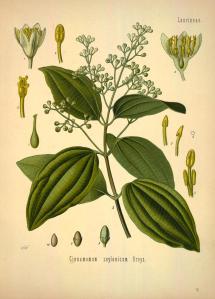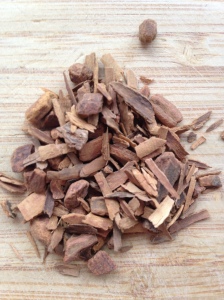Cinnamomum zeylanicum Common Name: Cinnamon Family: Lauraceae
Parts used: Inner bark and oil distilled from bark and leaves
Constituents: volatile oil (up to 4% consisting of cinnamaldehyde, cinamyl acetate, cinnamyl alcohol, cuminaldehyde, eugenol, and methyleugenol), tannins, cinnzelanin, cinnzelanol, coumarin, methylhydroxychalcone polymers
Medicinal actions: Aromatic digestive stimulant, astringent, carminative, styptic, anti- H. Pylori

Medicinal use: Cinnamomum is chiefly employed for its smooth muscles relaxing effects. It acts systemically in this regard and is thus useful in the treatment of hypertension, bronchial spasm, dysmenorrhea, diarrhea and spastic constipation and as a carminative. As a carminative, cinnamon is a useful companion to purgatives and is warming to the intestinal tract. The volatile oils in cinnamon are antibacterial, antifungal, and antiviral.
Pharmacy: Tincture (1:5) 2 – 7.5 ml/day. Oil 0.1 ml/day. Infusion 1 tsp/cup, 1 cup TID. Crude herb as food.
Toxicity: Adverse effects can be nausea or gastrointestinal burning. The concentrated oil in amounts > 0.5 ml/kg body weight can cause N/V, kidney damage, coma. Treatment is emesis or gastric lavage, activated charcoal, cathartic, maintain hydration and electrolytes.
Contraindications: Most are due to the extension of physiological effects of this herb in conditions that are exacerbated by GI stimulation (ie. Gastritis, hyperchlorhydria, GERD, biliary obstruction, acute cholelithiasis, with high doses of the volatile oil). The volatile oil may deplete glutathione in the liver and other tissues and should only be used in small doses for short periods of time. Overdose of the volatile oil can cause nausea, vomiting, convulsions, pulmonary edema and liver damage.
Interactions: The whole bark’s tannin content promotes gut motility and can interfere with absorption of many other medicines when taken simultaneously.
Research:
Extracts have been shown to increase glucose uptake in vitro.
- In a RCT of patients with type 2 diabetes living in Pakistan, administration of 1, 3, or 6 g/day for 6 weeks significantly reduced the mean fasting serum glucose level by 18029%. The reduction was similar for all 3 doses.
- At a dose of 1g/day for 3 months did not improve glycemic control in type 1 diabetics in one study.


Discussion
Comments are closed.